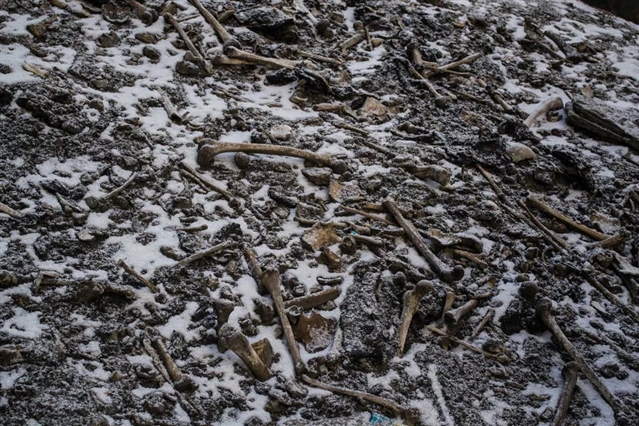论文标题:Ancient DNA from the skeletons of Roopkund Lake reveals Mediterranean migrants in India
期刊:Nature Communications
作者:Éadaoin Harney, Ayushi Nayak, Nick Patterson, Pramod Joglekar, Veena Mushrif-Tripathy, Swapan Mallick, Nadin Rohland, Jakob Sedig, Nicole Adamski, Rebecca Bernardos, Nasreen Broomandkhoshbacht, Brendan J. Culleton, Matthew Ferry, Thomas K. Harper, Megan Michel, Jonas Oppenheimer, Kristin Stewardson, Zhao Zhang, Harashawaradhana, Maanwendra Singh Bartwal, Sachin Kumar, Subhash Chandra Diyundi, Patrick Roberts, Nicole Boivin, Douglas J. Kennett, Kumarasamy Thangaraj, David Reich,Niraj Rai
发表时间:2019/08/20
数字识别码:10.1038/s41467-019-11357-9
微信链接:https://mp.weixin.qq.com/s/WW6H8b21sW_J2XBd0NCfqA
根据《自然-通讯》发表的一项研究Ancient DNA from the skeletons of Roopkund Lake reveals Mediterranean migrants in India, 研究人员提取了38具来自公元800年-1800年印度路普康湖(Roopkund Lake,俗称“人骨湖”)的人类骸骨的DNA,分析鉴定出了三个属于不同祖先的类群。这些骸骨因多次事件而堆积在此,时间相隔约1000年,其中14名个体可追溯至公元1800年左右,其祖先具有典型的东地中海人特征。

图1:路普康湖与附近的群山 版权:Atish Waghwase (atishwaghwase@gmail.com)
路普康湖位于喜马拉雅山脉海拔5000多米的地方,面积不大,周围散落着几百具人类骸骨。关于这些骸骨的来源,存在多种不同的假设;但是因为这个地方的特点,人们一直难以找到明确答案。

图2:路普康湖周围散落的骨头 版权:Himadri Sinha Roy (himsin1986@gmail.com)
美国波士顿哈佛医学院的David Reich、印度勒克瑙萨尼古生物科学研究所的Niraj Rai和同事对38具骸骨做了DNA分析和放射碳测年,鉴定出了三种遗传学迥异的类群——他们在不同的时间抵达路普康湖。具体而言,其中23名个体具有南亚人血统,可追溯至公元800年左右,并且有证据表明这些人不是一次性到此的;另有14名个体具有东地中海人血统,1名个体具有东亚人血统,他们都可以追溯至公元1800年左右。以上发现驳斥了过去的观点——所有这些骸骨都是因为某一次的灾难性事件而产生的。此外,还需要进一步开展文献研究,才能弄清楚为何会有地中海人在这里出现。
摘要:Situated at over 5,000 meters above sea level in the Himalayan Mountains, Roopkund Lake is home to the scattered skeletal remains of several hundred individuals of unknown origin. We report genome-wide ancient DNA for 38 skeletons from Roopkund Lake, and find that they cluster into three distinct groups. A group of 23 individuals have ancestry that falls within the range of variation of present-day South Asians. A further 14 have ancestry typical of the eastern Mediterranean. We also identify one individual with Southeast Asian-related ancestry. Radiocarbon dating indicates that these remains were not deposited simultaneously. Instead, all of the individuals with South Asian-related ancestry date to ~800 CE (but with evidence of being deposited in more than one event), while all other individuals date to ~1800 CE. These differences are also reflected in stable isotope measurements, which reveal a distinct dietary profile for the two main groups.
(来源:科学网)
特别声明:本文转载仅仅是出于传播信息的需要,并不意味着代表本网站观点或证实其内容的真实性;如其他媒体、网站或个人从本网站转载使用,须保留本网站注明的“来源”,并自负版权等法律责任;作者如果不希望被转载或者联系转载稿费等事宜,请与我们接洽。